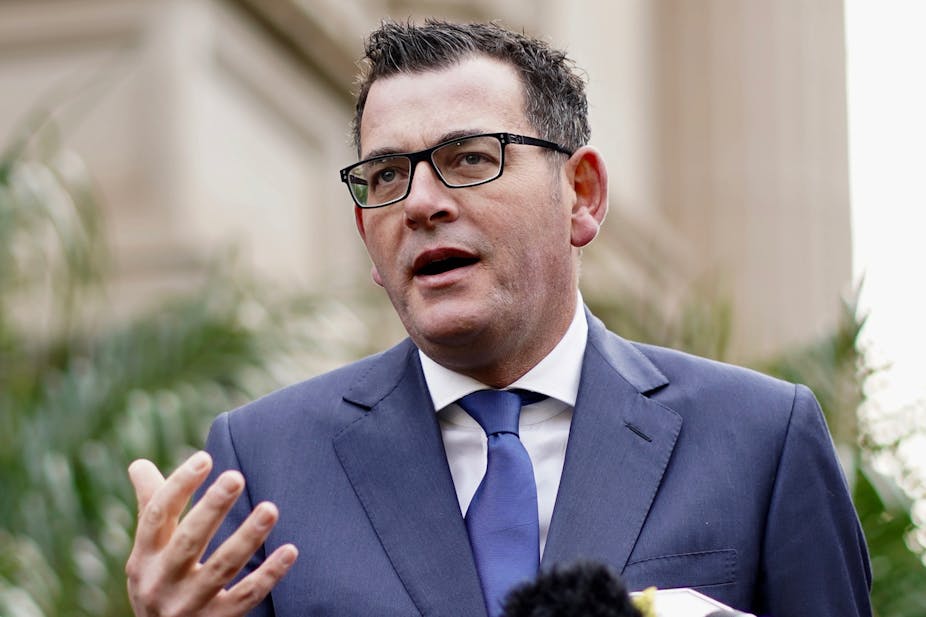A Victorian ReachTEL poll for The Age, conducted July 5 from a sample of 1,500, gave Labor a 51-49 lead. Primary votes were 39.4% Coalition, 35.4% Labor, 10.5% Greens, 3.6% One Nation, 2.8% Shooters and 3.5% undecided. The Victorian election will be held on November 24.
According to The Poll Bludger, if undecided voters were excluded, primary votes would be 40.8% Coalition, 36.7% Labor, 10.9% Greens and 3.7% One Nation. ReachTEL uses respondent allocation for its two party results, and this result is about the same as we would get using 2014 preference flows.
Premier Daniel Andrews led Opposition Leader Matthew Guy by a narrow 50.6-49.4 margin as better Premier. ReachTEL’s forced choice better Premier/PM question tends to be more favourable to opposition leaders than polls that do not use a forced choice.
In other forced-choice questions, Guy edged Andrews by 50.1-49.9 on who voters thought was more trustworthy. The Coalition had a 50.8-49.2 lead over Labor on party best to handle Melbourne’s congestion, a 51.6-48.4 lead on managing Melbourne’s growing population, and a 55.8-44.2 lead on law and order. Labor was just ahead by 50.2-49.8 on cost-of-living.
The responses to these issue questions are not good for Labor, but this poll did not ask about health, the economy and education, which are likely to be significant issues in voting decisions.
This ReachTEL is the first Victorian poll since a mid-April Newspoll, which also had Labor ahead by 51-49. If there is no early federal election, the Coalition will still be in power federally by the time of the state election. State parties tend to do better when the opposite party is in power federally. As Labor has a poll lead, and this is its first term, Labor will probably win the state election.
Read more: Poll wrap: Labor's Newspoll lead narrows federally and in Victoria
Time running out to abolish group ticket voting in Victorian upper house
All 40 upper house seats will be up for election at the state election. There are eight upper house regions that each return five members, so a quota is one-sixth of the vote, or 16.7%.
In early 2016, group voting tickets were abolished for the federal Senate, and in late 2017, they were abolished for the South Australian upper house. However, these tickets are still current electoral law in Victorian and Western Australian upper house elections.
Under group ticket voting, above-the-line voters cannot direct their own preferences. Instead, the party that receives a “1” vote controls that voter’s preferences. Votes can go to parties that are very different from the party that received the “1” vote.
The biggest problem with the group voting tickets is that the near 100% preference flows allow parties with negligible support to pass other parties, and then benefit from those parties’ preferences. At the 2014 state election, Vote 1 Local Jobs won the final seat in Western Victoria region on just 1.3% of the vote, or 0.08 quotas, a seat that should have gone to the Greens.
Read more: Proposed Senate electoral reform is essential
To direct their own preferences, votes must be cast below-the-line. It is easier to vote below-the-line in Victoria than in other jurisdictions, as only five numbered boxes are required for a formal vote.
New South Wales and South Australia now use optional above-the-line preferential voting. Voters are required to number “1”, and can continue with “2”, “3”, and so on if they wish. Votes will exhaust when there are no further preferences to allocate.
In the federal Senate, voters are told that six numbers are required above the line, but only one is needed for a formal vote. The reformed Senate voting system performed well at the July 2016 double dissolution election.
Read more: Further Senate results and analysis
There is no news regarding suggestions for electoral reform. I would be happy if Victoria adopted either the New South Wales or federal Senate models, but time is running out for electoral reform. Any proposal would need to pass both chambers of the Victorian parliament, likely needing bipartisan support. The final sitting day before the election is September 20.

